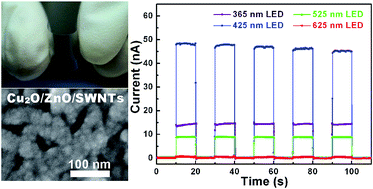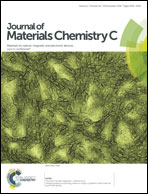A high-performance UV/visible photodetector of Cu2O/ZnO hybrid nanofilms on SWNT-based flexible conducting substrates†
Abstract
In this report, we present a photosensing unit based on single-walled nanotubes (SWNTs) integrated with Cu2O/ZnO hybrid nanofilms. 50 nm Cu2O and 50 nm ZnO nanofilms are respectively deposited on a SWNT-coated polyethylene terephthalate (PET) sheet via a two-step sputtering process. The Cu2O/ZnO nanofilm photodetector exhibits a rapid response (<100 ms), excellent responsive repeatability, robust stability and broadband photodetection range from 365 to 625 nm without external bias. Furthermore, the ZnO/Cu2O nanofilm photodetector has also been fabricated by changing the deposition sequence of ZnO and Cu2O. The photocurrent of the ZnO/Cu2O nanofilm photodetector is one-fourth of that of the Cu2O/ZnO nanofilm photodetector. We speculate that it might be attributed to the presence of the whispering-gallery mode (WGM) resonances in Cu2O/ZnO hybrid nanofilms owing to the higher refractive index of Cu2O, resulting in the enhancement of the light trapping and absorption. The high performance of the Cu2O/ZnO nanofilm photodetector indicates that the Cu2O/ZnO hybrid nanofilms on SWNT-based conducting substrates are suitable for mass production and application as high-sensitivity, fast response speed and flexible UV/visible photodetectors.


 Please wait while we load your content...
Please wait while we load your content...